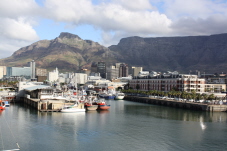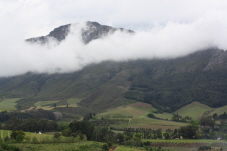By Susan Farewell
South Africa's coast-hugging Mother City, Cape Town, is a great place to set your sights on this year.
The city is sparkling in all sorts of ways. Creatively, it’s on the cutting edge of design and style. Culturally, its multiethnic population (including  strong Dutch, English and Cape Malay influences that date back hundreds of years) contributes to a lively mix of foods, fashion and music. It’s also a city that’s facing its tough past and ongoing challenges with clear eyes, and emerging as a living example of racial harmony for the world to see. strong Dutch, English and Cape Malay influences that date back hundreds of years) contributes to a lively mix of foods, fashion and music. It’s also a city that’s facing its tough past and ongoing challenges with clear eyes, and emerging as a living example of racial harmony for the world to see.
On top of that, it’s within easy reach of some of South Africa’s most spectacularly scenic land- and seascapes, its estate-dotted winelands, and some world-class game reserves and wilderness areas.
I’ve provided a handful of ideas of what to see and do while visiting, assuming you have under two weeks to spend in Cape Town and neighboring parts of the Western Cape. I recommend dividing your time between the heart of Cape Town, the Cape Peninsula and Winelands and Sanbona, a Wildlife Reserve.
Chances are great that this trip will just whet your appetite. You’ll want to come back to visit the beach resorts along the Garden Route and the game reserves of the Eastern Cape. And of course, there’s the rest of South Africa to see…which you can learn more about right here in coming months.
Start with the Heart of Cape Town
Cape Town is rife with galleries and museums, historic buildings and neighborhoods, shops and markets selling original African fashion and crafts, and creative restaurants, hotels and nightspots. Plan to spend at least three days exploring the City Bowl, the Victoria & Alfred Waterfront (which is both a working harbor and tourist hub) and some of the surrounding suburbs such as Camps Bay (which looks and feels like the French Riviera) and Constantia, the oldest wine-growing region in Southern Africa.
Don’t expect to do everything. Here’s a short list to set your sights on.
• Ride the cable car up Table Mountain, a great way to get the lay of the land sorted out in your mind. From the top, it’s also easy to understand why Cape Town has been described as one of the most stunning cities in the world. It’s cupped between wind-carved sandstone mountains and the shimmering Atlantic.
• Explore the Bo-Kaap District. This neighborhood, which is the spiritual home  of the Cape’s Muslim community, is full of gaily painted houses, a photographer’s dream. For an up-close look, take the cooking safari offered by Andulela, a small company that specializes in tours that emphasize experiencing the real South Africa. On this tour, you’ll be shown around the neighborhood (including the Bo-Kaap Museum and the Atlas Trading Company, which is stuffed with sacks of rices and bins of spices from the Far East), then move on to a private home, don aprons and learn how to make make samosas and other Cape Malay specialties. of the Cape’s Muslim community, is full of gaily painted houses, a photographer’s dream. For an up-close look, take the cooking safari offered by Andulela, a small company that specializes in tours that emphasize experiencing the real South Africa. On this tour, you’ll be shown around the neighborhood (including the Bo-Kaap Museum and the Atlas Trading Company, which is stuffed with sacks of rices and bins of spices from the Far East), then move on to a private home, don aprons and learn how to make make samosas and other Cape Malay specialties.
• Visit the District Six Museum, where the unspeakable story of what happened to the former residents of the district is told through letters, pictures, drawings, maps and other memorabilia.
• Board the ferry for Robben Island. Now a nature reserve and museum, this small island is where Nelson Mandela and other African National Congress members were imprisoned for many years and is without question, the most inhospitable of Apartheid prisons.
• Take a township tour. The half-day tour offered by Roots Africa Tours takes you through the layers of South Africa’s history through a black person’s eyes including where it started, the Apartheid years and the new South Africa, since Mandela was released from prison. It includes a visit to Khayalitsha, a township in which the vast majority of Cape Town residents live.
• Don’t miss the Kirstenbosch National Botanical Gardens, where you can see many varieties of the stunning fynbos (fine bush), a flora that’s endemic to a small section of the Western Cape of Africa.
Further Afield: Heading South on the Peninsula
Exploring the peninsula that runs south of Cape Town can easily fill the better part of a day, and is worth it for the sp ectacular coastal scenery and wildlife viewing alone. ectacular coastal scenery and wildlife viewing alone.
Between mid-July and December, the waters off of South Africa are busy with Southern Right Whales, on their way back from the Antarctic. They come here to calve, breed and mate in the warm waters. As you travel south alongside False Bay from Fish Hoek to Smitswinkel Bay, you can actually see them from the road.
There is also a colony of African Penguins to see, crowding the beach and rocks in Simon’s Town.
The Cape of Good Hope marks the southwestern most point of the African continent (NOT the southernmost which is a common misconception). Nevertheless, it has that end of the land, nothing from here on, look about it. Wind-slammed cliffs rise against the sea, holding their own, as if in a powerful standoff.
The Cape Winelands
Can life get any better than driving through magnificent scenery, stopping to sample wines and phenomenal food? You’ll find yourself asking that over and over again in the Cape Winelands. Allow at least three or four days to visit the wine estates and restaurants that are tucked away in the hillsides and valleys south and east of Cape Town. The South African wines you taste are winning awards left and right and increasingly competing on the world wine stage. A few of the restaurants and chefs are getting world-recognition as well.
While traditionally the Cape Winelands referred to the area around Stellenbosch, Paarl and Franschhhoek, which are just under an hour east of Cape Town, some of the vineyards of the Cape are just minutes away including those of the Constantia Valley in the southern suburbs. Here you’ll find Groot Constantia, South Africa’s oldest wine estate. Nearby is the Steenberg Hotel & Winery, where you’ll want to plant yourselves for the better part of an afternoon. Settle in at a table outside at its restaurant, Catharina’s, and you won’t be able to take your eyes off the view—spic and span white Dutch architecture against a backdrop of the Steenberg Mountains.
Heading east, outside Stellenbosch, which is South Africa’s oldest town and the cradle of Afrikaans culture, you’ll find the new, modern Delaire Graff Estate, a winery that’s every inch a conversation piece with artwork, gardens and cutting-edge design throughout. Its setting is arrestingly beautiful, in the crest of the Helshoogte Mountain Pass.
 From there, it’s a short distance to the Paarl Valley, which was one of the first regions of the Cape to be settled by the French Huguenots and Dutch over 300 years ago. The architecture and agricultural savoir faire they brought with them lives on. You’ll see more of it in the nearby town of Franschhoek. Surrounded by the magnificently scenic Franschhoek Mountains, it’s home to many small boutiques and eateries but perhaps most notably, it’s where you can sample the culinary sensations of Michelin-star Chef, Margot Janse at The Tasting Room at Le Quartier Francais. Diners choose the five or eight-course meals, which include special dishes of local game—warthog, impala and springbok. Country cousin to Le Quartier Francais is Bread & Wine, a lunch-only eatery at the nearby Moreson Wine Farm showcasing the charcuterie skills of chef Neil Jewell as well as his wife Tina’s artisan breads and Moreson wines by the glass or bottle. From there, it’s a short distance to the Paarl Valley, which was one of the first regions of the Cape to be settled by the French Huguenots and Dutch over 300 years ago. The architecture and agricultural savoir faire they brought with them lives on. You’ll see more of it in the nearby town of Franschhoek. Surrounded by the magnificently scenic Franschhoek Mountains, it’s home to many small boutiques and eateries but perhaps most notably, it’s where you can sample the culinary sensations of Michelin-star Chef, Margot Janse at The Tasting Room at Le Quartier Francais. Diners choose the five or eight-course meals, which include special dishes of local game—warthog, impala and springbok. Country cousin to Le Quartier Francais is Bread & Wine, a lunch-only eatery at the nearby Moreson Wine Farm showcasing the charcuterie skills of chef Neil Jewell as well as his wife Tina’s artisan breads and Moreson wines by the glass or bottle.
Sanbona: A Private Game Reserve
No trip to South Africa would be complete without a safari. Nice to know that within three hours of the city, you can be out in the bush, binoculars up, seeing any one (or several) of the five high-profile animals. Located in the heart of the arid Little Karoo, Sanbona is South Africa’s largest privately-owned wildlife reserve. It sprawls over 133,000 acres, about the size of Singapore.

The trophy spotting for all who visit are the white lions. Sanbona is home to the only free-roaming pride in the world. All the animals here (including giraffe, cheetahs, elephants, rhinos, hippos) were brought in to the reserve in the last ten years in an effort to reclaim their natural habitat from the centuries of hunting and farming that took place.
The reserve is also home to over 200 species of birds, plantlife and cave paintings that are as much 3,500 years old.
Stay at least two nights in one of the safari lodges—including a tented camp—before plugging yourselves back into the excitement of Cape Town.
|

